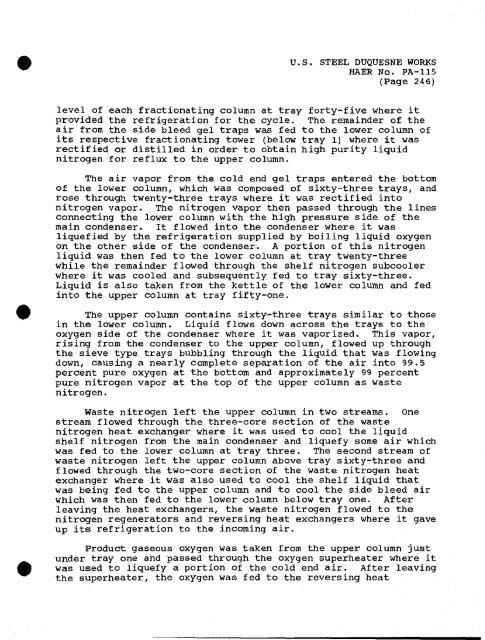pa1778data.pdf
pa1778data.pdf
pa1778data.pdf
Create successful ePaper yourself
Turn your PDF publications into a flip-book with our unique Google optimized e-Paper software.
A U.S. STEEL DUQUESNE WORKS<br />
W HAER No. PA-115<br />
(Page 246)<br />
level of each fractionating column at tray forty-five where it<br />
provided the refrigeration for the cycle. The remainder of the<br />
air from the side bleed gel traps was fed to the lower column of<br />
its respective fractionating tower (below tray 1) where it was<br />
rectified or distilled in order to obtain high purity liquid<br />
nitrogen for reflux to the upper column.<br />
The air vapor from the cold end gel traps entered the bottom<br />
of the lower column, which was composed of sixty-three trays, and<br />
rose through twenty-three trays where it was rectified into<br />
nitrogen vapor. The nitrogen vapor then passed through the lines<br />
connecting the lower column with the high pressure side of the<br />
main condenser. It flowed into the condenser where it was<br />
liquefied by the refrigeration supplied by boiling liquid oxygen<br />
on the other side of the condenser. A portion of this nitrogen<br />
liquid was then fed to the lower column at tray twenty-three<br />
while the remainder flowed through the shelf nitrogen subcooler<br />
where it was cooled and subsequently fed to tray sixty-three.<br />
Liquid is also taken from the kettle of the lower column and fed<br />
into the upper column at tray fifty-one.<br />
^P The upper column contains sixty-three trays similar to those<br />
in the lower column. Liquid flows down across the trays to the<br />
oxygen side of the condenser where it was vaporized. This vapor,<br />
rising from the condenser to the upper column, flowed up through<br />
the sieve type trays bubbling through the liquid that was flowing<br />
down, causing a nearly complete separation of the air into 99.5<br />
percent pure oxygen at the bottom and approximately 99 percent<br />
pure nitrogen vapor at the top of the upper column as waste<br />
nitrogen.<br />
Waste nitrogen left the upper column in two streams. One<br />
stream flowed through the three-core section of the waste<br />
nitrogen heat exchanger where it was used to cool the liquid<br />
shelf nitrogen from the main condenser and liquefy some air which<br />
was fed to the lower column at tray three. The second stream of<br />
waste nitrogen left the upper column above tray sixty-three and<br />
flowed through the two-core section of the waste nitrogen heat<br />
exchanger where it was also used to cool the shelf liquid that<br />
was being fed to the upper column and to cool the side bleed air<br />
which was then fed to the lower column below tray one. After<br />
leaving the heat exchangers, the waste nitrogen flowed to the<br />
nitrogen regenerators and reversing heat exchangers where it gave<br />
up its refrigeration to the incoming air.<br />
Product gaseous oxygen was taken from the upper column just<br />
under tray one and passed through the oxygen superheater where it<br />
A was used to liquefy a portion of the cold end air. After leaving<br />
^^ the superheater, the oxygen was fed to the reversing heat

















